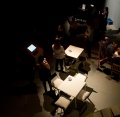In My Mind’s Eye: Difference between revisions
No edit summary |
m (Text replacement - "{{Work" to "{{Graduation work") |
||
| Line 1: | Line 1: | ||
{{ | {{Graduation work | ||
|Description=In My Mind's Eye is a machine that allows the user to automatically, without effort, make personal associations between images. These associations lie deep within them, but will surface when the images are presented in a taxonomical way; the human brain is designed to see patterns, a narrative. The user is asked to create a meaningful set of images and name it; the set will then be printed and become a playable card game. The project aims to collect different types of results, based on personal experience, or the subjective interpretations of public events. The project also allows the users to compare and exchange their decks of cards and the meanings associated with them. | |Description=In My Mind's Eye is a machine that allows the user to automatically, without effort, make personal associations between images. These associations lie deep within them, but will surface when the images are presented in a taxonomical way; the human brain is designed to see patterns, a narrative. The user is asked to create a meaningful set of images and name it; the set will then be printed and become a playable card game. The project aims to collect different types of results, based on personal experience, or the subjective interpretations of public events. The project also allows the users to compare and exchange their decks of cards and the meanings associated with them. | ||
|Creator=Mirjam Dissel, | |Creator=Mirjam Dissel, | ||
Latest revision as of 17:59, 31 March 2015
| In My Mind’s Eye | |
|---|---|
| Creator | Mirjam Dissel, |
| Year | 2012 |
| Bio | |
| Website | http://mirjamdissel.com/project/in-my-minds-eye/ |
In My Mind's Eye is a machine that allows the user to automatically, without effort, make personal associations between images. These associations lie deep within them, but will surface when the images are presented in a taxonomical way; the human brain is designed to see patterns, a narrative. The user is asked to create a meaningful set of images and name it; the set will then be printed and become a playable card game. The project aims to collect different types of results, based on personal experience, or the subjective interpretations of public events. The project also allows the users to compare and exchange their decks of cards and the meanings associated with them.








